Portulaca, more commonly known as purslane, is a wide genus of flowering perennial plants containing over 100 individual species. Some species have bred cultivars and are particularly useful as edible salad crops.
We’ll guide you through planting and caring for purslane in this article, and share some of our favourite species to grow in Australia.
More...

Family: | Portulacaceae |
|---|---|
Genus: | Portulaca |
Species: | Various |
Common names: | Purslane |
Location: | Indoor or outdoor |
Type: | Edible, ground cover, herbaceous perennial |
Growth: | Varies by species |
Sun requirements: | Varies by species, prefers full sun to part shade |
Foliage colour: | Green or glaucous |
Flower colour: | Red, white, pink, yellow, orange |
Flowering: | Summer through to the first frost |
Edible parts: | Most species have edible leaves and flowers. Some are toxic. |
Maintenance level: | Low |
Poisonous for pets: | Toxic to pets |
What is Portulaca?
Portulaca is a genus of around one hundred flowering perennial plants better known by the common name ‘Purslane’. Caring for portulaca is straightforward, but understanding your chosen varieties is essential to success, and knowing how to grow portulaca will depend heavily on which species you choose.
Most varieties of purslane are low-growing plants, used as trailing pot plants in horticulture, or as edible salad leaves in kitchen gardens, but some grow as domed or prostrate shrubs.
Nearly all varieties spread to around 1m across, but some have dwarf habits, and grow to just a few centimetres in size (these are often used for aqua-scaping aquariums).
Note that not all species of Portulaca are edible. Thicker-stemmed species, like Portulaca molokiniensis, have high levels of saponins in the stem and leaves and can induce vomiting.
Portulaca Habitat and Climate Requirements
Portulaca, or Purslane, is one of the most common plants on earth. Hundreds of species are widely spread across different continents and in different growing conditions on each.
The best-known Portulaca species are the coastal varieties, which add to their culinary appeal, thanks to the salty flavour of foraged leaves. However, many grow inland and spread through grassland and in the understory of woodlands.
While most types you can grow at home prefer well-drained poor soils, others need rich loam or boggy conditions, and others grow best in salt bogs.
In this guide, we’ll focus on growing culinary purslane at home, which requires occasional watering, annual feed, and full sun. The varieties below offer some insight into more varied species and cultivars.
Portulaca Varieties, Species and Cultivars
Out of hundreds of species, and dozens of cultivars, there are surprisingly few that are readily available to grow in our gardens, and the range is limited further by those that are happy in Australian climates.
All of the species and cultivars below are reasonably drought tolerant and offer either edible or ornamental value indoors and out.
1. Portulaca oleracea
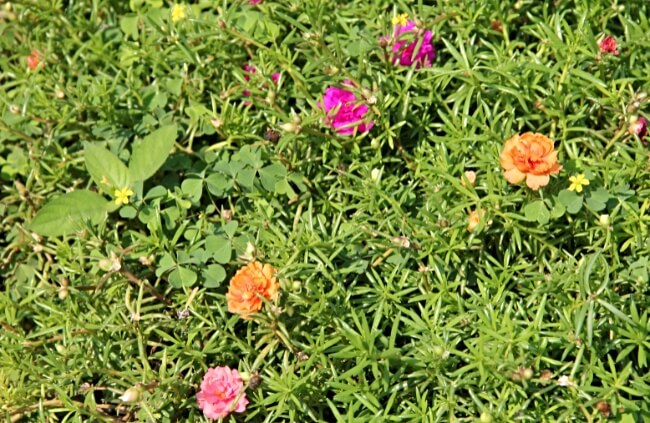
Portulaca oleracea is the most commonly grown edible purslane and one of the most common found in nature. It is also a sub-tropical Australian native and works well in pots in most gardens with full sun and good drainage.
The deep and earthy flavour of this useful, perennial, spinach substitute is worth trying if you’ve never grown purslane before.
Refer to our comprehensive guide to growing Portulaca oleracea for more details.
2. Portulaca grandiflora
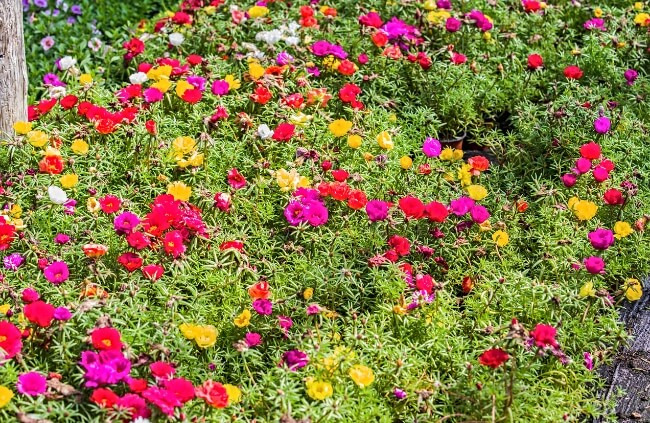
Portulaca grandiflora is the standard breeding species for cultivated ornamental purslanes. Its dramatic double flowers can be found in a huge variety of colours and it grows well on nearly all soil types provided there is reasonable drainage, good sun, and it doesn’t get too cold in winter.
Most of the cultivars below are hybrids or direct cultivars of P. grandiflora.
3. Portulaca pilosa
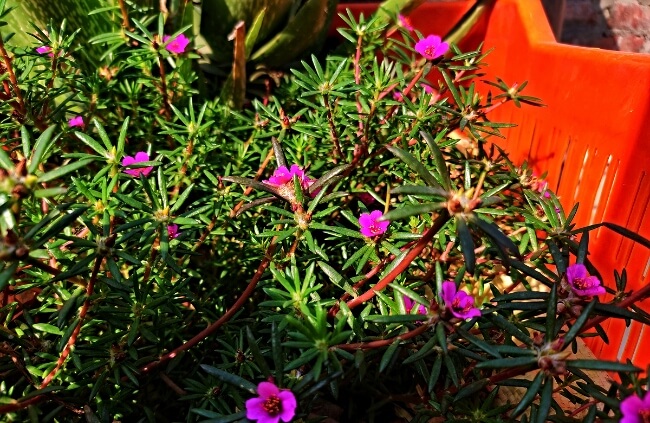
Portulaca pilosa is an American native, with the common name ‘hairy pigweed’. Its symmetrical, succulent leaves are capped with small bright pink flowers. It can be invasive in Australia, so it’s best to grow it as an indoor plant, or deadhead regularly for containerised plants outdoors.
Like other Portulaca species, its leaves are edible, and flatter leaves on plants with less irrigation are more delicate in salads than P. oleracea.
4. Portulaca umbraticola
Another species often used in cultivated varieties to introduce colour to hybridised plants is Portulaca umbraticola. Its pink, white or yellow flowers are unpredictable, and seeds can come up in any colour, but its foliage develops in neat florettes, in sequence along each stem, with bright, bold flowers that make it perfect for patio pots.
5. Portulaca molokiniensis
Portulaca molokiniensis is a non-edible species, native to Hawaii. Its thick woody stems host florettes of highly succulent leaves at their tip, meaning they are often mistaken for aeoniums.
The thick sap inside the stem and leaf contains saponins – the natural substance used to make traditional soaps, and can be a skin irritant when not prepared, and induce vomiting when eaten.
Despite its lack of culinary appeal, Portulaca molokiniensis is one of the most stunning succulents you can grow in Australia. It grows well outdoors, doesn’t spread without intervention and copes well with our climate.
6. Portulaca australis
Portulaca australis is a fascinating edible plant. As its species name suggests, it is native to Australia and is relatively easy to grow. However, in nearly all cultivated settings, including in its natural range, it acts as a short-lived perennial.
It thrives on absolute neglect, and in nature, these plants can go on living and spreading for decades. The best way to care for them is to plant them in poor, free-draining soil and hope for the best. The less you do, the more you will get.
7. Portulaca bicolor
This common Australian native, found growing wild across most coastal ranges in the country, is Portulaca bicolor. Its round, succulent, leaves develop on red stems that lie flat to the ground, and even in flower, it is rarely taller than 5cm.
It is a wonderful plant for rockeries or small terracotta pots, adding a touch of the seaside to gardens anywhere in the country. The small but vibrant pink flowers make it a wonderful ornamental crop, with edible uses as a bonus, rather than its main purpose.
8. Portulaca filifolia
Portulaca filifolia doesn’t offer much in the way of ornamental appeal. It’s a leggy, sparse plant with messy green succulent foliage and sparing yellow flowers. And its slender leaves don’t add much to salads either.
The real appeal of Portulaca filifolia is the root. That does mean you’ll need to take cuttings to keep your stock going each year, but this can be done from root cuttings, or stem cuttings with ease.
The tuberous roots have an earthy flavour like potato with a texture like Jerusalem artichoke and are delicious sliced thinly into salads or cooked.
9. Portulaca africana
The elephant bush, Portulaca africana, is a South African native shrub, growing to around 20cm tall at most. It is an excellent houseplant, and an even better garden pot plant, providing trailing ground cover without ever getting too dense.
Like most purslanes, its leaves are edible and noted for having a particularly sour, almost fruity taste.
10. Portulaca amilis
Portulaca amilis is one of our absolute favourite ornamental species. Its bright pink blooms are completely dazzling and deadheading can extend flowering for several months.
Its leaves are technically edible but are not widely eaten, offer little flavour, and can cause gastric upset if eaten too often. This South American native is commonly called Paraguayan purslane and grows best in sandy soil or disturbed soil with an open structure.
Popular Portulaca Cultivars
As well as the naturally occurring Portulaca species, there are a few excellent ornamental cultivars that add colour and drama to garden borders and can look even better indoors as houseplants with the right care and attention.
11. Portulaca ‘Happy Hour’
Portulaca ‘Happy Hour’ is a P. grandiflora cultivar, with spectacular double flowers and blooms so garish in colour that they were too much even for 1970s gardeners.
But, if you’ve got a thing for colour, they are a great and much lower-maintenance alternative to colourful begonias, offering jaw-dropping perennial bedding colour for a fraction of the effort.
12. Portulaca ‘Sunseeker’
Portulaca ‘Sunseeker’ is a gently muted version of Portulaca ‘Happy Hour’. Bred from double-flowered grandiflora types, but with a dwarf habit, they are ideal for pots and hanging baskets, with a very limited spread.
They flower continuously throughout the year with an occasional liquid feed and regular deadheading.
13. Portulaca ‘Happy Trails Deep Red’
There are a few variations on Portulaca ‘Happy Trails’, and all feature the same reliable trailing habit, which only gets better as the years go by. Prune each year to improve blooming, and feed well through summer to extend flowering.
Deadheading also helps to increase the flowering time for this stunning rich red-flowered purslane.
14. Portulaca ‘Mojave® Red’
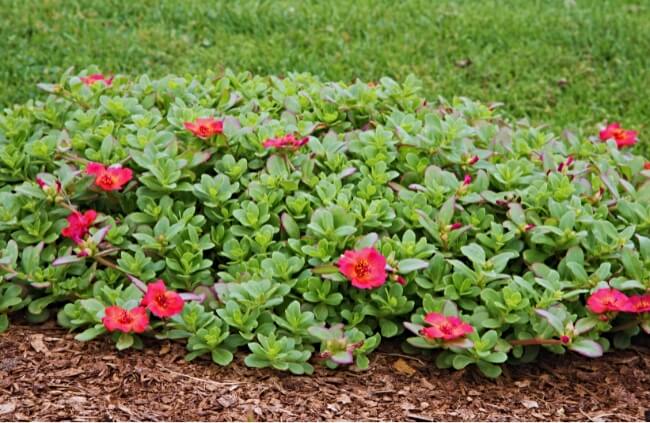
Mojave® Portulaca types are ideal plants for gardeners who want colour and drama, without the guilt of double-flowered cultivars restricting access for pollinators. These open flowers, red purslanes with a bright yellow centre, offer food for bees, and colour for us.
And if that wasn’t enough they have one of the longest flowering seasons of any ornamental purslane and one of the densest flowering forms.
15. Portulaca ‘Fairytales Cinderella’
If any plant has ever earned such a magical fairytale name, it is Portulaca ‘Fairytales Cinderella’. I can only imagine the joy on the breeder’s face the first time it flowered.
Not only is this gorgeous ornamental perennial a perfectly structured double flower, with a tight pompom in the centre of each flower, but the outer petals are a creamy, custard yellow, with a bright rhubarb-pink central dome.
Paired with their year-round foliage interest, which is tipped with red on young growth, this has become one the most sought-after Portulaca cultivars there is (myself included).
16. Portulaca ‘Mojave® Tangerine’
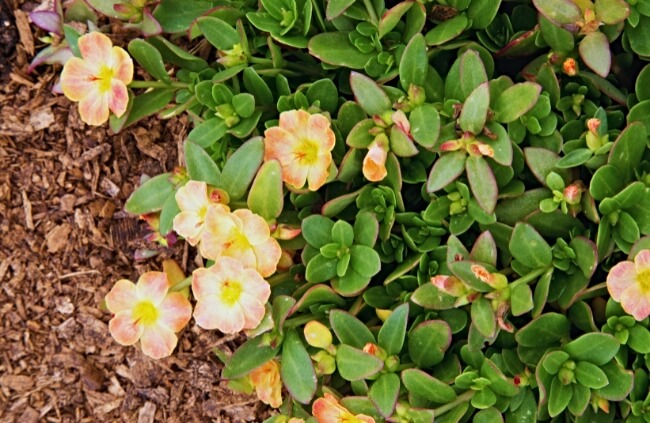
Another cultivar from Mojave®, bred from Portulaca umbraticola, is ‘Mojave® Tangerine’. Its ruffle single flowers have all the texture of grandiflora types, but offer a sought-after nectar source for bees and butterflies.
Beneath the summer-long marmalade-coloured flowers lies an evergreen carpet of highly succulent leaves, with fine white spotting and a red leaf border.
How to Grow Portulaca in Australia
Portulaca is incredibly easy to grow, provided you choose the right variety, and for the more ornamental varieties, feeding is more important than you might imagine.
In the guide below, we’ll run through the process of growing portulaca from seed to harvest. The guide applies to edible purslanes as well as flowering ornamental cultivars.
How to Propagate Portulaca
Propagating Portulaca from Seeds
Portulaca grows brilliantly well from seed, which is viable for up to 40 years if stored correctly in cool, dry, dark, conditions. Cuttings and division are also possible, and especially simple for purslane grown in pots, which can be separated every other year to produce new and more vigorous plants.
Method:
- Fill a seed tray with peat-free compost in early spring or late autumn
- Sow purslane directly on the surface of the soil, and do not cover
- Keep the soil moist but not soaking, and position the tray in full sun, at 20-25°C
- Germination takes 10-20 days
- When seedlings have true leaves and are large enough to handle, plant into individual pots willed with a mix of peat-free compost and perlite
How to Propagate Portulaca from Cuttings
Portulaca cuttings are incredibly simple to take. They can be taken like strawberries, with runners pinned into pots of compost while they are attached to the parent plant, or rooted in clean water.
Every node in contact with the soil has the potential to create a new plant, so lay portulaca cuttings flat across moist compost, and pin them down with wire. Cover the pot or tray with clear plastic to retain humidity, and keep them somewhere warm, but out of direct sunlight.
Rooting is usually quick, and each node should root within 7 days, and show vigorous new growth after a month.
When you notice new growth from each node, snip the original stem so each plant develops separately. Plant them into individual pots when two or three new sets of leaves have developed.
Portulaca Propagation by Division
The easiest way to create new portulaca plants and maximise your stock of purslane is to divide existing plants. Many species of purslane can send roots into nearby soil, so propagate themselves readily.
In early spring, while the temperature is still reasonably cool, just remove your purslane from the pot, and pull away new plants along natural divisions, taking as much root as possible.
Plant them into new pots – just big enough to accommodate the roots.
Ideal Conditions for Planting Portulaca
You can direct sow portulaca in mid-spring for crops in late summer, but I find it is generally more reliable and provides stronger plants when they are sown in autumn and then planted out in spring (helping to avoid the temptation to harvest the rich foliage until their second year).
But, gardeners without seed-sowing space, or cold frames to protect young plants, will often find purslane for sale in garden centres, both the edible and ornamental varieties.

Best Time of Year to Plant Portulaca
Portulaca is most productive through summer and autumn in Australia but can be harvested all year round. The best time of year to plant it, like most herbaceous plants, is early spring when the winter weather has faded and plants are starting to grow more vigorously.
If planting indoors, you can plant portulaca at any time of year, and the same goes for sowing portulaca seeds. Purslane is a versatile plant and adapts well to planting all year round as long as young plants are protected from extreme weather.
Where to Plant Portulaca
Portulaca works well as a kitchen windowsill herb, but will always perform better outdoors, with proper ventilation and the opportunity to stretch its legs. If planting indoors, make sure you use a well-drained potting mix and a pot that is wider than it is deep.
Portulaca can develop extremely long roots – which makes it a very useful soil stabilisation plant – but it doesn’t have to. In cultivation, where it is watered reasonably regularly, and planted into a good free-draining compost mix, purslane will only root as much as it needs to.
Offering a deep pot creates the potential for waterlogging in disused soil, so choose your container wisely.
How Much Sun Does Portulaca Need?
Nearly all purslanes sold commonly around Australia require full sun or light shade. We have managed to grow some on our northeast-facing patio in pots, but they tend to be leggy with deeper green-coloured foliage, and much weaker flavour.
The ornamental flowering purslane we’ve grown in the same position flowered poorly, and thrived as soon as they were moved to full sun at the front of the house.
Preparing the Soil and Drainage
As we mentioned above, and as illustrated by the wide variety of species and cultivars, purslane is a plant genus with mixed needs. Some will grow in clay, others in sand. However, edible purslane and ornamental varieties tend to prefer free-draining soil with some organic matter.
For that reason, we nearly always grow it in pots, and when it's out in the garden, dig a few handfuls of leaf mould and horticultural grit to help with draining and nitrogen availability.
A small amount of compost goes a long way with purslane and will be enough to feed your plants for their first year or two. After that, an annual liquid feed, or a sprinkle of poultry manure pellets gives them all the nutrients they need, whether it's to encourage flowering or boost foliage strength.
How to Plant Portulaca
Portulaca is a tough plant, but that doesn’t mean it doesn’t deserve proper care and attention when you introduce it to your garden. Like all young plants, above-average watering will help its roots to establish, and the introduction of organic matter means that nutrients are available until the roots set into the surrounding soil.
Below, we’ll focus on spacing, planting depth, how and when to water newly planted purslane and some clever ways to maximise its usefulness with simple companion planting tips.
Plant Spacing
Portulaca spreads well, so if planting in beds or borders, make sure that plants are spaced at least 25cm apart.
In time they will intermingle and spacing won’t matter, but allow young plants to breathe, and reduce competition with adequate spacing while they get established.
Depth for Planting
On heavy soils, loam or wet clay, plant portulaca slightly proud of the soil surface with a 2-3cm mound above the earth. This will prevent the crown of the plant from getting waterlogged, which can lead to crown rot, and encourage root issues more generally.
In sandy soils, or free-draining conditions, portulaca can be planted level with the soil surface.
Watering In
Whether planting portulaca in a container or in the ground, young plants should be watered in well. For plants in pots, that means watering them until water drains from the base of the container.
For purslane planted in the ground, soak the earth around the plant once a fortnight for its first summer.
Portulaca Companion Plants
Portulaca isn’t a particularly useful companion plant in the vegetable garden but can offer some distraction to slugs and snails from other prized veggies. It is, however, an incredibly useful ground cover plant for your garden borders, and works wonders as a trailing layer in mixed pots.
Use flowering purslanes alongside dramatic upright herbaceous plants like oriental poppies or anemones, and for even more drama, plant a few large allium bulbs around each purslane plant.
That way, when your purslane spreads out, the tough allium bulbs will push through, offering drama and colour against a base of garish mixed purslane flowers.
How to Care for Portulaca
Caring for portulaca is simple. Once it has established, it will just go on and on. In most conditions, portulaca is a long-lived perennial, producing edible leaves or vibrant flowers for at least a decade, and easily replacing itself by spreading across the ground and rooting from its stems.
Unless there is a severe drought, purslane doesn’t need additional watering or irrigation, as its succulent leaves of most varieties are a natural adaptation to this.
What it does need, both for ornamental purslane and edible purslane, is feeding. This can be done by sprinkling slow-release fertilisers onto the soil surface or using balanced liquid feeds.
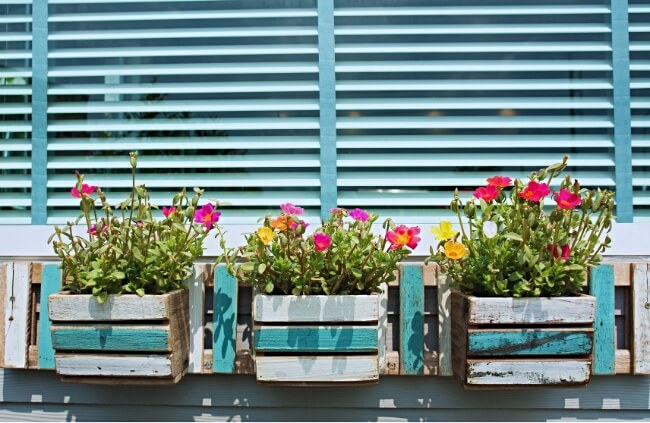
Best Fertilisers for Portulaca
Purslane is a simple plant, with limited nutritional needs, so depending on the time of year, and your reason for feeding it, there are three very different fertilisers worth having in the shed – and they happen to be great all-rounders for houseplants, veggies and herbaceous garden plants alike.
1. Tomorite
Levington Tomorite is one of the best all-around fertilisers for any edible garden. Use it for a quick nutrient boost if your purslane plants are looking tired towards the end of summer. It gives a great boost to perennials and annuals alike.
Its NPK content is reasonably balanced (4:3:8), with a focus on fruiting and flowering, but not so significantly that you will damage foliar growth. It is an essential garden shed, and every garden should have a bottle, whether it's for tomatoes or purslane.
2. Charlie Carp Pellets
Charlie Carp uses culled European carp as the base of their fertiliser products. The balanced fertilisers they produce are ideal for the vegetable garden and help to manage and maintain Australia’s delicate natural balance.
Charlie Carp Natural Pellet Fertiliser are a useful slow-release fertiliser for purslane and other salad leaves. Simply sprinkle a small handful onto the soil surface in spring, and it will feed plants for up to six months.
3. Charlie Carp Liquid Feed
Charlie Carp’s liquid feed is a mid-level feed. It helps to improve the soil structure as well as adding nutrients, similar to liquid seaweed (but much cheaper). This 2L bottle is excellent value and offers balanced fertiliser and helps to maintain soil structure.
Feed once or twice a year in summer, either in addition to or instead of the pellet feed.
Harvesting and Storing Portulaca
Edible uses for portulaca are generally as a flavouring for other dishes, rather than as the core component of a salad. Its rich, earthy vegetal flavour lends itself well as an addition to casseroles and soups too.
It is an acquired taste, thanks to its mucilaginous texture, but it adds an undeniable depth of flavour to any dish it’s added to, and a little goes a very long way.
Harvest portulaca leaves whenever they are available, whether that’s in mid-winter for indoor, potted purslane, or mid-summer and autumn for outdoor plants. They have maximum flavour when picked in the morning when the tart varieties have a richer citrusy flavour.

Storing Purslane for Edible Use
While preserving or storing purslane as a fresh herb or salad leaf is virtually impossible, long-term storage is possible in the form of pickling. Pickled purslane is a stunning flavour, not dissimilar to capers, and has similar uses.
Chopped pickled capers, sprinkled over a winter salad of wild rocket and crisp radicchio is utterly stunning and well worth a try. Any standard sugar and vinegar pickle recipe can be used, but we add a few mustard seeds and leave sugar out entirely for something closer to jarred capers.
Common Portulaca Pests and Diseases
Portulaca is susceptible to root rot and has a distinct preference for free or well-drained soils. If planted on damp ground, or regularly overwatered it is susceptible to crown rot.
Root rot occurs in quite rare circumstances, so if you suspect a case of crown rot, the safest thing to do is to cut the whole plant back to the ground and let it dry out. Lifting the root ball will tell you if it’s root rot. Otherwise, just leave it to dry out and the whole plant should recover in a few weeks during summer.
There are no specific diseases to be concerned about with portulaca. As above, overwatering can cause some common fungal problems, but they are rarely fatal, and if controlled do not spread to other plants.
Many species of purslane are considered to be environmental weeds, so despite their beauty and culinary use, several initiatives were launched to control the spread of wild, non-native purslane, particularly along Australian coasts.
So, aside from slugs and snails, there are two specific pests to look out for: purslane sawfly (Schizocerella pilicornis) and the leaf miner weevil (Hypurus bertrandiperris).
Both were introduced with the intention of damaging non-native purslane species, but they also cause issues for kitchen gardeners and anybody growing ornamental varieties. They can be controlled with organic insecticides, but avoid spraying on edible crops as even organic insecticides can be harmful to humans.
Portulaca Frequently Asked Questions
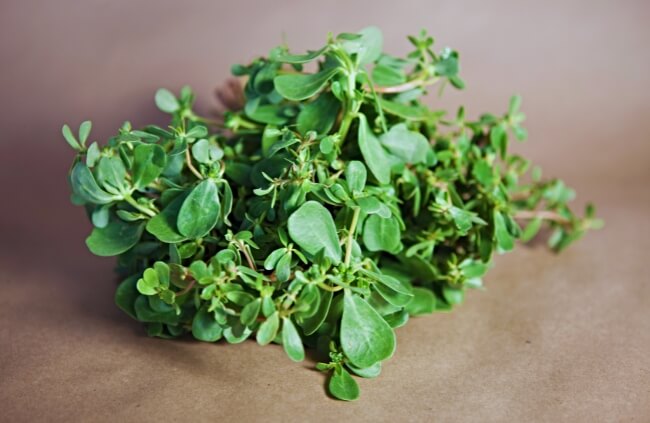
Where does portulaca grow best?
Portulaca grows best in full sun, in any soil that has good drainage. The colder the weather, the slower the purslane grows.
Is portulaca cut and come again?
Portulaca is a great cut-and-come-again crop. In Australia, it is a perennial herb in nearly all states, and provided it doesn’t drop below freezing, it can be harvested month after month, and year after year.
How long does it take for portulaca to grow?
Portulaca is a fast-grown plant, with leaves often ready to pick in as little as two months after sowing. However, if you wait a little longer and let a good root system develop, you will get much more from your purslane plants, and they can continue growing after even a heavy harvest.
Who should not eat portulaca?
Portulaca contains oxalic acid, which is critical in the formation of kidney stones. Anybody with kidney disease or a history of kidney stones should avoid purslane.
Is portulaca good for the garden?
Portulaca is a low-nutrient feeder, so won’t take much out of your soil. At the same time, it will benefit your veggies garden by covering the soil and blocking out weeds.
Should I deadhead portulaca?
Flowering ornamental portulaca, rather than edible purslane crops, benefit tremendously from deadheading, which encourages a longer flowering season, and keeps plants looking tidier for longer.
Can portulaca be a houseplant?
There are many species and cultivars of portulaca that work very well as a houseplant. The flowering cultivars with pink or yellow blooms look particularly wonderful set in a bright windowsill with semi-regular watering.
What can be mistaken for portulaca?
Portulaca is a great bush tucker food for foragers, but it can be easily mistaken for Euphorbia maculata (spotted spurge). Always check the colour of the sap before eating, as spurge is highly toxic.
Spurge has a white sap from the leaf and stem, while purslane has a clear to green sap inside the leaf.
Add Low-Maintenance Beauty to Your Garden with Portulaca
Portulaca, or purslane, isn’t nearly as popular as it deserves to be. It is one of the most uniquely flavoured and richest salad leaves you can grow, and with potential pickling options to bring even deeper flavour to your cooking, there shouldn’t be anything standing in your way of growing this outstanding crop.
Even if you don’t like the idea of growing this tough crop as an edible, there are countless applications in garden design for more ornamental varieties. Get out there, find one you like and grow portulaca yourself. You’ll soon be converted.
Published on June 4, 2023 by Gary Clarke
Last Updated on May 3, 2024




